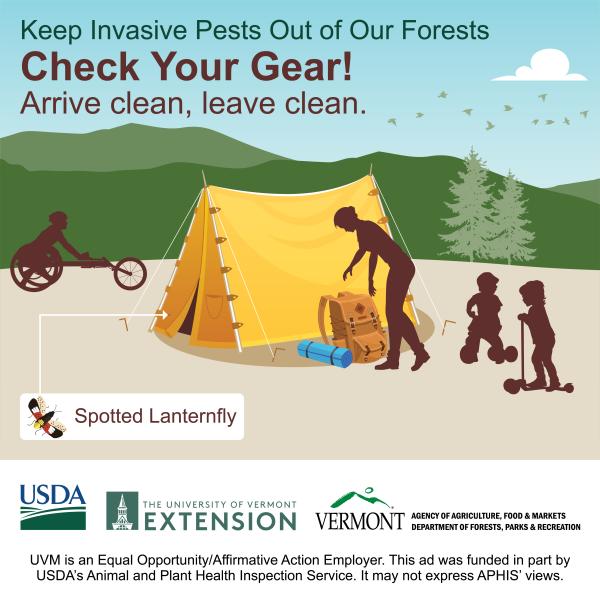
News Source
For many Vermonters and out-of-state visitors, summer means camping, hiking and taking part in other outdoor recreational fun. However, these activities can all spread invasive plants, insects and diseases, unless steps are taken to minimize damage to the environment.
University of Vermont (UVM) Extension; the Vermont Department of Forests, Parks and Recreation; and the Vermont Agency of Agriculture, Food and Markets have teamed up to inform and educate outdoor recreationists about what they can do to prevent the introduction of or spread of these pests through their new Arrive Clean, Leave Clean campaign.
The purpose of this outreach campaign, launched in June, is to encourage anyone who spends time outdoors to follow three steps when leaving the woods. These are to clean their gear, check their vehicles for egg masses or other life stages of spotted lanternfly and not to move firewood.
According to Ginger Nickerson, UVM Extension forest pest education coordinator, “Although the spotted lanternfly has not been reported in Vermont, it has been confirmed in neighboring states, including New York and Massachusetts. All life stages of this invasive pest can hitchhike long distances on vehicles and infest new locations, thus the need to be vigilant.”
The same is true for other invasive species not yet detected in Vermont as following the same three steps will help prevent their spread. These species include oak wilt, a fungal disease that has killed millions of oak trees nationwide; the Asian longhorned beetle, which attacks maple trees; and the hemlock woolly adelgid, which willdecimate entire stands of hemlock, leading to loss of deer habitat and cooling of streams for trout.
“Invasive plants, insects and pathogens can be spread unknowingly by people,” Nickerson points out, “changing the forest landscape as we know it. Although we can’t do anything about the spread of invasive species by birds, animals and wind, many pathways are under human control, including through outdoor recreation.”
Because invasive plant seeds and insects can lodge in dirt in boot or bike treads, or hide in the folds of clothes or gear, it’s important to clean all gear before and after heading outdoors to avoid dispersing insects or their eggs to new areas.
Consider keeping a brush in your vehicle to brush off boots, clothing, bicycles and gear, especially any gear that has been stored outdoors, before heading out on a trip, and when returning from the forest.
If you have traveled to a state where spotted lanternfly is established, Nickerson recommends inspecting your vehicle before returning to Vermont. The adults especially like to lay eggs on rusty metal, so carefully examine wheel wells and other areas on vehicles. The egg masses look like patches of dried mud and are not easy to detect.
One of the most common ways invasive pests are spread is by campers moving firewood long distances, whether within Vermont or from outside the state. Most insect eggs or diseases are too small to see, or are hidden inside the log, so campers and hunters can inadvertently introduce a forest pest to a new area. Although convenient to bring firewood from home, to avoid transporting pests, buy or gather firewood close to where it will be burned or buy certified treated firewood.
To learn more about the campaign and measures to control invasives, go to vtinvasives.org/arriveclean.